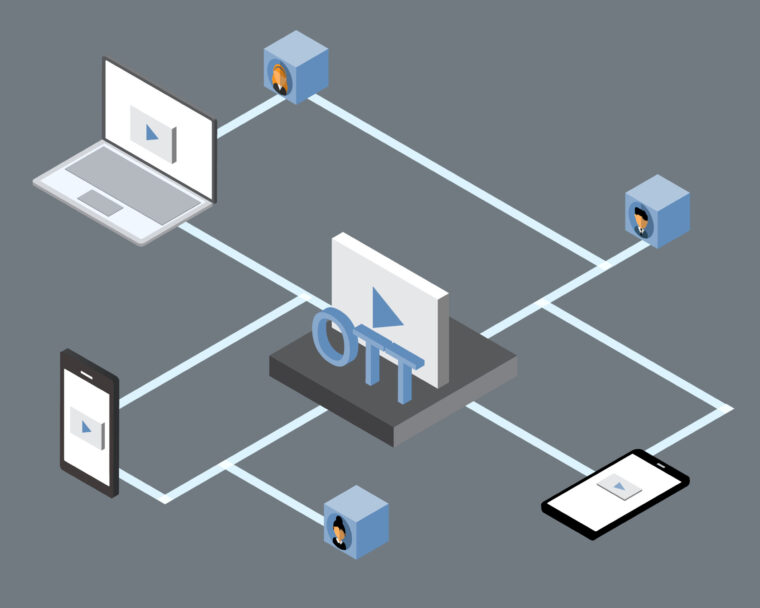Over-the-top or OTT and connected TV (CTV) devices are the most popular methods of accessing TV/video content. However, these terms can be easily confused with one another. So, it is important to understand the differences between connected TV and OTT advertising.
OTT is the mechanism through which TV/video content is delivered online through video on demand (VOD) and streaming in addition to traditional network providers. As of 2023, 38% of all TV usage is streaming. 1.8 billion have subscribed to a streaming service.

Connected TV is a device with an internet connection capability that customers use to watch TV/video content online. CTV can be a smart TV, gaming console, or another device that allows an internet connection to deliver TV/video content. CTV devices can also be used to stream OTT content.
Benefits of OTT Advertising
- Brand Safety – Ads are delivered during live TV or On-Demand.
- Reach across top-tier networks and popular content.
- 100 percent view guarantee as all ads run full screen, so 100 percent of pixels are in view and eliminate below-the-fold ads of other media options.
- Almost Perfect Ad Completion. This means that OTT ads have an average completion rate of 98 percent, which is the average time that a video ad is watched all to the end.
Some of the Devices Classified as CTV Devices Include:
- Smart TVs- are televisions with a built-in internet connection and media platform. No additional elements are needed to stream videos on the TV.
- Connected devices – They plug directly into your TV and have an internet connection, enabling video streaming and apps to be used on the television, whether the TV is a smart TV or not. These channels include Amazon Fire Stick, Apple TV, Roku and Chromecast, and gaming consoles with internet connectivity like PlayStation.
Benefits of CTV Advertising
With Connected TV advertising, you will reach viewers that advertisers cannot reach without traditional TV commercials.
Some of the benefits include:
- Superior Targeting Capabilities
With CTV audience targeting, you are assured that your marketing dollars will reach your most valuable and targeted viewers.
- Measurable Results
The major difference between CTV advertisements and other types of programmatic media is the metrics to track. Viewers are not on a laptop and cannot click right away like they would a display ad. That means that using CTV for awareness campaigns is the most effective. You will have to track the performance of a CTV campaign through metrics such as cost per completed view (CPCV) and video completion rate (VCR). CTV has programmatic platforms that allow you to measure the results of your Connected TV campaigns using both digital and traditional metrics, including video completion rates.
- CTV also has enhanced targeting options, inventory selection, and real-time reporting.
With CTV, it’s possible to leverage a similar campaign setup and target as other programmatic media buys like native, display, and video advertising. Therefore, like with any programmatic campaign, you can assess progress against goals and metrics while a campaign is live.
- Growing Audience.
According to the statistics by Nielsen, in 2020 alone, the total hours spent with CTV devices was up 81 percent year over year. Most advertisers also express interest in learning the demographics most likely to watch their shows on CTV devices. For instance, eMarketer found that younger audiences are more likely to be CTV viewers. The older demographics are also switching from traditional TV.
CTV adoption has been accelerating, with many CTV viewers watching ad-supported content. Viewers in the US and Europe prefer to watch free-to-view programming versus paying to watch the same content without ads. Furthermore, eMarketer, found out that more than one-third of US households will have cut the cord by 2024. Cord-cutting can also refer to viewers who are reducing the number of hours of subscription TV viewed in favor of TV content served via the Internet.

The Differences Between CTV and OTT
To truly understand the difference between OTT and Connected TV, let’s compare each platform. This will help to better understand their role in the programmatic advertising landscape.
- CTV is a subset of OTT, which includes apps and services that don’t require subscriptions to traditional cable or pay-tv services.
OTT doesn’t require a physical cable box because it broadcasts “over-the-top” of the traditional cable framework. Here’s a real-world example to help better understand how to view connected TV vs. OTT; Viewers who watch Netflix on their mobile devices are streaming OTT content. But what if they were to watch Netflix through a Chromecast that’s plugged into their television? In that case, they’re streaming OTT content over CTV.
The ins and outs of OTT
In terms of usage when it comes to advertising, the two can be used interchangeably, but the difference comes down to the devices on which the ads are served.
If served exclusively on a TV screen, OTT advertising transforms the TV into a performance marketing channel, which means advertisers can target audiences (using either first or third-party data) on their OTT/CTV device across ad-supported shows on premium networks. These networks vary depending on the type of CTV advertising platform that you’re using. MNTN, for example, partners only with brand-safe and top-tier networks like CNN, CNBC, and ESPN. After your OTT ad is screened, you can track who has visited your brand’s website and converted from watching your ad.
Connect with us today to get custom pricing on your next marketing project using streaming.
Final thoughts
So, what’s the bottom line? OTT advertising is video content delivered online through smart devices, including traditional closed TVs. On the other hand, CTV refers to TVs capable of connecting to the Internet to access content beyond what a cable provider offers. The big (and most important) difference is that OTT can be served on mobile and desktop, while Connected TV is only served on television screens. OTT should not be confused with Connected TV advertising – they are two different things! As you can see, there are some key differences, but ultimately, they both serve the same purpose: getting your video content in front of consumers.

